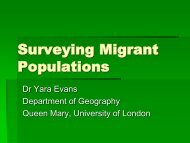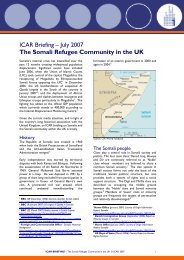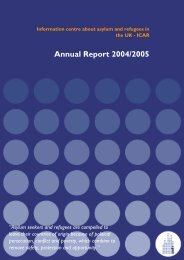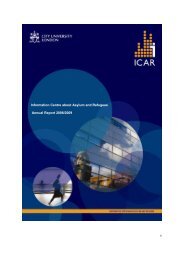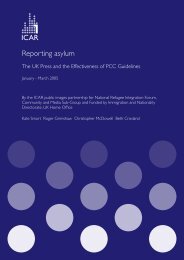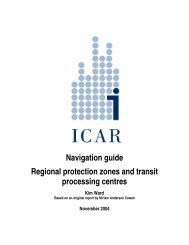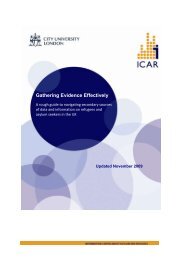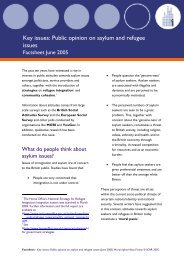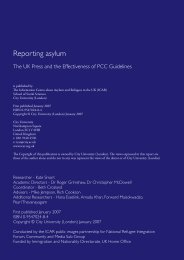Uncovered: assessing media and communications needs ... - ICAR
Uncovered: assessing media and communications needs ... - ICAR
Uncovered: assessing media and communications needs ... - ICAR
- No tags were found...
Create successful ePaper yourself
Turn your PDF publications into a flip-book with our unique Google optimized e-Paper software.
Refugee <strong>and</strong> migrant organisations also tend to have the lowest membership – this may refl ect theirstructural development or the size of their potential ’constituency’. The other categories are more likelyto be well established <strong>and</strong> have larger ‘constituencies’.Fig.13.3 Current <strong>media</strong> <strong>and</strong> <strong>communications</strong> activityThe most common forms of communication used by organisations are websites <strong>and</strong> newsletters. Veryfew organisations author blogs, produce fi lms or are involved in direct advertising. New technology isbeing used only in its most basic form, possibly suggesting that organisations do not have the skillsor time to develop into other areas or have not received appropriate training in the potentiality of suchtechnologies.Activities not listed in the questionnaire but mentioned in the ‘other’ category include seminars,conferences, events, <strong>and</strong> a multi-lingual website. CDs <strong>and</strong> PowerPoint presentations are alsomentioned.Since the ‘newsletter’ option did not differentiate between hard copy <strong>and</strong> electronic versions it isnot possible to draw conclusions about the level of sophistication involved. However evidence fromfocus groups suggests newsletters are generally produced electronically before being distributed inelectronic <strong>and</strong> paper format. Indeed representatives from the rural voluntary sector singled out desktop publishing as a particular training need.Refugee <strong>and</strong> migrant worker groups are notable for their relative lack of output in all categories, withfaith groups almost matching them in the relatively low production of news releases. Respondentsin the ‘isolated rural’ category have a high output in all categories relative to other groups. The othercategories were found to have a medium output relative to the other groups. This perhaps refl ects theresources organisations have to publicise their work <strong>and</strong> their degree of knowledge <strong>and</strong> training of theavailable marketing/publicity mechanisms.18 <strong>Uncovered</strong>: <strong>assessing</strong> <strong>media</strong> <strong>and</strong> <strong>communications</strong> <strong>needs</strong> <strong>and</strong> capacity of marginalised communities





